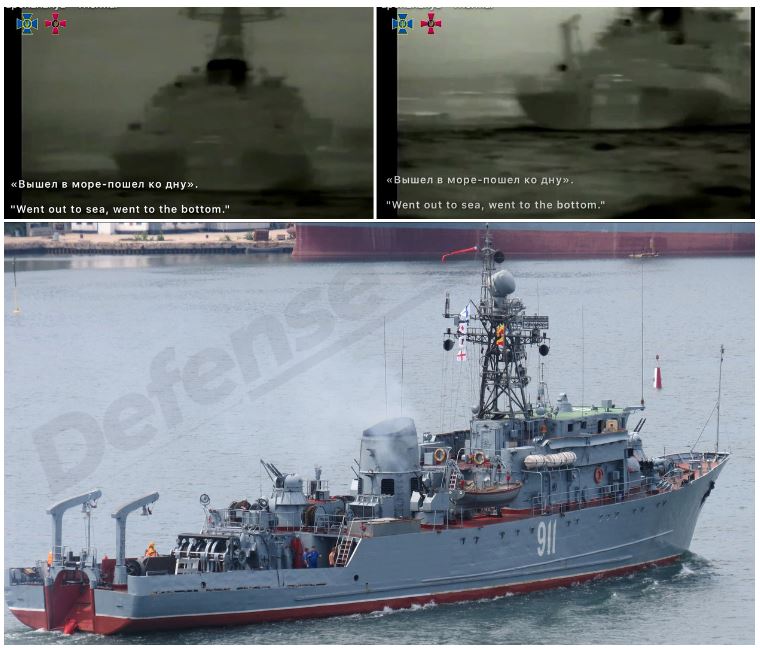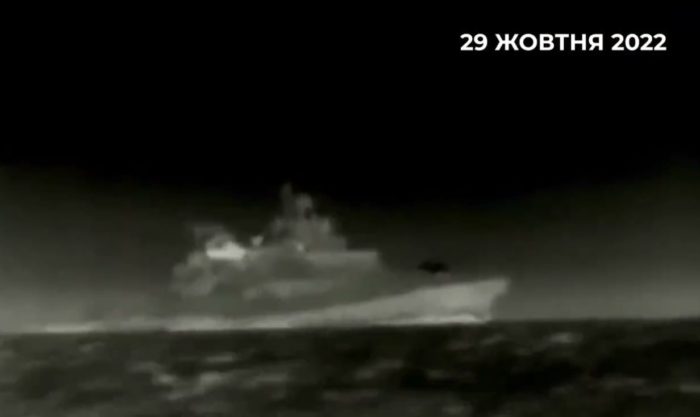The Ukrainian drone attack on the Russian fleet in Sevastopol of occupied Crimea was a “unique event, that will be no less significant in the history of Russia’s war” than Ukraine’s liberation of Zmiinyi Island from Russian occupation and blitzkrieg in Kharkiv Oblast, in which Ukraine retook more land from Russia in five days than Russia managed to occupy from Ukraine during five months. So military expert Volodymyr Zablotskyi assessed the mysterious naval operation reported to damage three Russian ships on 29 October on the air of Radio NV.
Here are four things to know about the surprise attack in which enigmatic surface drones reportedly disabled Russia’s current flagship Admiral Makarov.

1. Ukraine’s drone attack on Sevastopol was unprecedented in military history
It was the first combined attack of surface and aerial drones on vessels stationed in a protected bay in the history of naval battles, according to Zablotskyi. Although attacks on the enemy’s fleet in its base are nothing new, this was the first-ever remote attack, in which operators were located hundreds of kilometers away.
“As a method, this is nothing new. But the means involved are fully consistent with the postulates of the war of the future, […] called the war of drones,” he says.
Commander of the Suomenlinna Coastal Regiment Ville Vänskä agrees that the attack represents a novel development in naval warfare.
“A country with no operational navy has encroached over a superior enemy at its home base… The American Civil War introduced armor, pivoting gun turrets, and bowsprits to naval warfare. Crimean war sea mines and Sino-Japanese war torpedoes. Now the war in Ukraine clearly brings unmanned [weapons] to an inseparable part of naval warfare. Unmanned systems are developing much faster than technology forecasts. The spread of unmanned vehicles is explained not only by technical development and low cost, but also by their usability in tasks where human life is at risk.”
As well, the incident showed that Ukraine is becoming well-versed in the language of asymmetric warfare. As Naval News put it, noting that Ukraine was trained in the doctrines of NATO to effectively use its air, land, and limited sea power,
“Ukraine took the asymmetric threat to a new level by attacking Russian ships at their mother base with the kamikaze USVs. […] As in the case of the striking of the Crimean bridge, which is strategically important for the Russians, the Ukrainian forces attack critical targets in order to gain psychological superiority and damage the reputation of the Russian Armed Forces.”
Noting that the sinking of Russian flagship Moskva on 14 April 2022 was already a blow to the self-esteem of the Russian Navy, Naval News adds:
“The damage to the new flagship Makarov, as a result of a plan developed with a common understanding of operations and the product of very good intelligence work within the logic of the network-centric operation, is a great success for Ukraine and a reason for failure and shame for Russia.”
2. The attack caught Russia off guard

The group of surface drones managed to get deep into the bay of occupied Sevastopol, where the Russian vessels were stationed, without being noticed. They attacked two to four ships by surprise in the night, causing massive explosions, according to footage from surveillance cameras.
As the Polish Defense-24 writes, the Russians only began defending themselves when Ukraine launched the second wave of attacks after sunrise, using artillery, machine guns, and helicopters sent in from Sevastopol.
Unverified video from surveillance camera in Sevastopol purports to show massive explosion in night of drone attack, rumors of damage to 🇷🇺fleet are spreading. “Governor” Razvozhaev says cameras will now be closed to public
📽️ Military journo Tsaplienko https://t.co/BP6ie8C6qL pic.twitter.com/xvZPhbq3bY
— Euromaidan Press (@EuromaidanPress) October 29, 2022
“The most interesting thing is the inactivity of the frigate, which was in motion, and its main air and surface detection radar ‘Friegat’ was probably on (its antenna was rotating). Moving at night, a darkened ship should additionally have a navigation radar turned on, which is specially adapted to detect small boats (such as, for example, fishing boats). Either the watch was ‘asleep,’ or the Russian radar equipment did not meet the requirements set for it,” Defense-24 notes about the Russian ships being caught off guard.
3. Russian flagman damaged in Ukraine’s drone attack on Sevastopol
Footage of the attack published by Ukrainian journalists was analyzed by Ukraine’s defense portal Defense Express, which the ships targeted by the explosive surface drones.
Ukrainian journalist Andrii Tsaplienko published an extended version of the alleged Ukrainian attack of the explosive uncrewed surface vessels on the Russian warships
1/2
📹https://t.co/AabMivsdqX pic.twitter.com/h544WBMVDU
— Euromaidan Press (@EuromaidanPress) October 29, 2022
A frigate of the Admiral Grigorovich class (project 11356R, NATO code Burevestnik) is seen in the footage. There are two vessels of this type in the Black Sea: Admiral Makarov, which became the flagman of Russia’s Black Sea fleet after Ukraine sunk the previous one, Moskva; and Admiral Essen.

Defense 24 notes that the surface drones most likely targeted the part of the frigate where the combat information center is located, likely in hopes of targeting the nearby eight-position vertical launch launcher, where Oniks anti-ship missiles and Kalibr cruise missiles used by Russia to regularly shell Ukrainian cities were kept.
Meanwhile, Russia has admitted only damage to the Ivan Golubets minesweeper, the silhouette of which is recognizable in the second episode of the attack.

Damage to one of the project 11365 frigates is, in terms of combat readiness and prestige, a larger loss than the much-publicized sinkage of Moskva, Defense 24 notes. The outlet claims that the loss of Moskva was a typical propaganda loss, because its real value on the modern battlefield was negligible, while the Burevestnik frigates are modern ships that made Russia’s Black Sea Fleet a significant force in the Black Sea.
4. New Ukrainian Unmanned Surface Vehicle used in the attack
Both the independent defense analyst H I Sutton and Defense Express agree that the drone used in the attack is the same vessel that washed up on the shores near occupied Sevastopol on 21 September.
***UPDATE***
Now beyond any reasonable doubt that the type of surface drones used by #Ukraine to attack Russian Navy in Sevastopol today were same as one previous found near the base. #OSINT
Reference https://t.co/vpJFzEniD6
And https://t.co/YWqnJzWTqc pic.twitter.com/bX0vZvC1Hk— H I Sutton (@CovertShores) October 29, 2022
The kamikaze-USV was reported about by the Russians, who studied the vessel before destroying it.

“This object looks quite high-tech. In the upper part of the drone vessel we can see something like Starlink receiving terminal and an optoelectronic station for reconnaissance. And in the bow – something like contact detonators for detonating explosives. However, it is unclear where exactly the drone is supposed to contain the explosives,” Defense Express wrote.
A visual comparison of the footage in the video of the attacks with the photos of the USV shared by the Russians allowed Defense Express to conclude that it was indeed this model that rammed into the ships in Sevastopol bay.
2/2 In occupied Sevastopol, “at least three Russian Kaliber missile carrier ships were damaged. Among them is the Admiral Makarov frigate. There is a good chance that several ships are not just damaged, but sunk,” Tsaplienko wrote. pic.twitter.com/Sm370TMW9D
— Euromaidan Press (@EuromaidanPress) October 29, 2022
In April 2022, the Pentagon sent an unspecified number of “unmanned coastal defense vessels” to Ukraine.
Pentagon Press Secretary John Kirby told then that the USVs “can be used for a variety of purposes in coastal defense” and were coming from the Navy stocks, FedScoop reported.
Kirby declined to tell more, but Bryan Clark, director of the Center for Defense Concepts and Technology at the Hudson Institute, explained to FedScoop then that the ships the Pentagon was giving to Ukraine were likely designed for intelligence, surveillance, reconnaissance and countermine operations, but didn’t rule out that they could be potentially used to directly attack Russian ships.
“I would not be surprised if the Ukrainians, once they start using them, think about ways to put lethal payloads on them,” he said. “Once they get them, the Ukrainians can choose to equip them however they want. So, I wouldn’t be surprised if the Ukrainians incorporate, you know, maybe some weapons systems on there in case they want to use those to attack Russian ships.”
Such weapons could potentially include small missiles that are essentially “guided rockets,” or machine guns. Alternatively, the Ukrainians could load the boats with explosives and ram them into Russian vessels like al-Qaida operatives did to the USS Cole in 2000, he said.
At least three Russian ships damaged in blasts in Sevastopol – media (updated, video)


